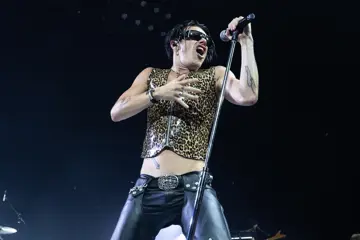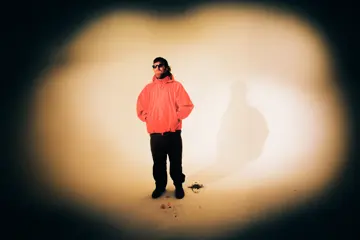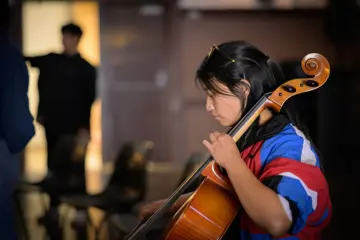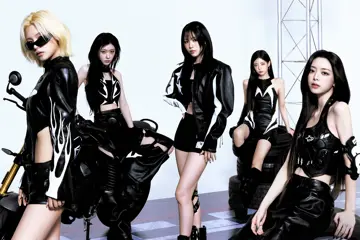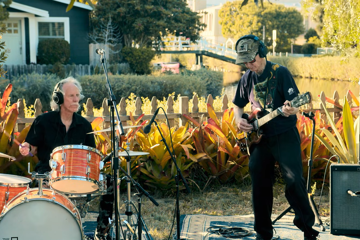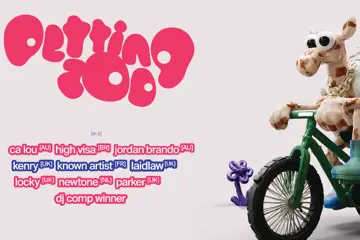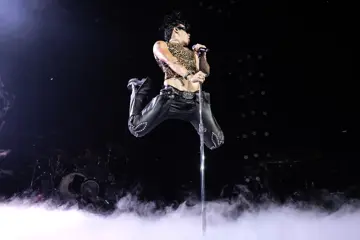Aquaman
★
Aquaman cost $160mil to make, but, god, does it look cheap. There are four credited writers on Aquaman, but, fuck, is this thing stupid. There’s a whole multinational marketing apparatus that’s going to sell you on going to see Aquaman, but, lord, don’t do it. Unless you really want to see Dolph Lundgren with a pink CGI beard that ripples underwater.
In the latest instalment in the DCEU —one of the greatest ongoing crimes against cinema ever perpetrated— much of the action takes place amongst the ‘seven kingdoms of the sea’, in an underwater world, where, sure, maybe you can suspend disbelief that people can breathe and talk and an octopus can play tribal drums to soundtrack a gladiatorial battle.
But why are there fiery explosions underwater? And why are people wearing shoes? If some of the Atlanteans, after their ancient kingdom sank underwater, evolved fish-like tails, why is Amber Heard topping off her Princess-Ariel-by-way-of-ABBA sequined emerald onesie with a pair of wedge heels? Why is Jason Momoa’s righteous Aquaman leaping into the sea wearing steel-cap boots, jeans, a belt, and a chain wallet? And why is everyone getting about in the deep sea wearing armour?
This is yet another example of the worst elements of fantasy. When offered the opportunity to create whole new worlds of wildest imagination, writers instead regurgitate the same stock mock-medieval clichés: hereditary rule over kingdoms, brothers battling to be king, manly men in armour riding about on (sea)horses, armies clashing in some grand cod-LOTR CGI battle. There’s also many underwater fights, which are all very boring, having nothing on the underwater fight from Top Secret!.
Don't miss a beat with our FREE daily newsletter
The moments of invention are saved for the Flintstonian gambit of imagining underwater creatures as domesticated slaves, beasts of burden, and tools for use; which is sometimes funny (that octopus playing the drums, sure, but also Heard wearing a princess dress made of bioluminescent jellyfish) but mostly just generic (bad guys riding on the backs of sharks).
Otherwise, there’s underwater stormtroopers, villains speaking in evil voices, a painfully-predictable “you’re still alive!” reveal, a giant sea monster voiced by Julie Andrews (shades of the sexy-posh Rachel Weisz Dragon from the forgotten Eragon movie), and a moment where Patrick Wilson has to say “call me... Ocean Master!” with a straight face.
As bad as the underwater stuff is —this is runamok CGI at its most awful, weightless, and visually repellent— things are even worse above land. It’s there that Momoa and Heard must engage in painfully-unfunny, unsexy-sexual-tension banter as they set out on a D-grade Tomb Raider quest to retrieve some elaborate mystical MacGuffin. If you can forgive the endless army of wage-slave digital-animation workers for failing to make an elaborate underwater kingdom scan as ‘real’, it’s far less forgivable that the sand-dunes of the ‘Sahara’ look so patently ersatz, Momoa and Heard clearly walking along some digital backlot’s endless green-screenery, plonked atop a desert that wouldn’t pass muster in a late-’90s video-game.
As they go off on their side-quest, there’s a host of unexplained wardrobe changes and astounding leaps of logic. There’s also a terrible shootout/action-sequence set in ‘Sicily’ (shouts to the Gold Coast), in which lots of stuff blows up and people run along rooftops and through walls, this officially the place where Bourne-franchise tropes have gone to die.
When Aquaman can’t even get the above-ground stuff right, you know the whole magilla is destined to be a grand, expensive failure. If ever any film was emblematic of Hollywood at its worst, it’s gotta be this: an unwanted universe instalment of a mediocre IP, brought to screen with a host of slumming actors delivering fantasy-wonk lines whilst suspended from wires, pretending (poorly) to be in an underwater kingdom. It’s a terrible idea, executed terribly; one of the worst films of this or any other year.
Ralph Breaks The Internet
★★★
Just in case you didn’t notice when it came officially billed as Disney’s Ralph Breaks The Internet, there’s a moment in Disney’s Ralph Breaks The Internet where the narrative’s Secret-Life-Of-The-Internet lark takes a totally-natural and not-at-all-forced tour to OhMyDisney.com. There, the Wonderful World Of Disney comes to life in a collision of parachuted-in, Disney-owned IP: there’s Star Wars stormtroopers and robots, Muppets, Groot from the MCU, and, of course, eventually, all the Disney princesses.
This princess-team-up-sequence turns out to be strange, in-joke-riddled commentary on the clichés peddled by Disney, a sleight-of-hand that once subverts and reassures panicky parents about the grotesque morality of old, Prince-Charming-populated fairy-tales; a have-their-cake-and-eat-it-too moment where a Disney movie turns into an ad for Disney, yet it’s ‘okay’ because the moment is way-meta. In the same way, the gaping maw of the internet —where everything is funnelled into the same all-consuming ‘feed’— eventually means that, ultimately, there’s little difference between the movie as entertainment, the movie as advertisement, and the movie-adjacent #content as dual advertisement.
In a way that’s somewhere between insidious and ingenious —a tone we’re used to greeting with a shrug— Ralph Breaks The Internet welcomes these concerned commentaries upon its morality, because this is a film that, in an almost Pixarist fashion, is operating on two levels. Its predecessor, 2012’s Wreck-It Ralph, was a grand shrine to 8-bit-arcade imagery whose marketing was pure parental-nostalgia. Here, as its principle characters —a Donkey Kong-esque destroyer/lunk and a cutesy go-kart racer, voice with much charm by John C. Reilly and Sarah Silverman, respectively— go on a journey into the internet, it’s a colourful adventure-of-self-discovery for kids, and a terrifying parable for anxious parents. Amidst a furious farrago of memes, references, in-jokes, gamer nostalgia, and corporate-partner branding opportunities, the moral of the story is essentially that the internet is a place for people’s dreams that, collectively, turns into one grand nightmare.
Vice
★★★1/2
Shouts to whoever did the wigs this time around. Where Adam McKay’s last comic skewering of the hyper-capitalist America —the subprime-bubble satire The Big Short — paraded a collection of celebrity actors in distracting wigs, here the prosthetics, dentures, and hair-pieces don’t distract from another wry, satirical, meta-movie look at All-American imperialism and corruption. Christian Bale piles on the method-acting weight-gain (hello, Oscar nom!), and is slathered in all manner of old-man latex; but his portrayal of former US Vice President Dick Cheney transcends its make-up-chair trappings because of how he makes his character feel like an oft-contradictory human, not some sketch-show impersonation.
McKay effectively frames Vice as a heist: Cheney grifting a rube (George W. Bush) for access to power, and then getting the band together for one great, big, long, history-alteringcon. It’s a film about the American political system, the conservative news media, the fossil fuel industry, the War On Terror, and the collusion that occurred —and still occurs— between all parties. The tone is irreverent throughout, with to-camera digressions and explanations, illustrative imagery (lots of fly-fishing lures, reeling people in), and the damning, ironic use of real-life videos showing the savage suffering caused by America’s various W.-era wars. Wars, of course, plotted by power-mongering, bellicose, boy’s-club conservatives aiming for access to the oil fields of the Arabian peninsula.
It’s a what-to-do-but-laugh comedy about a country’s wayward immorality, one that’s —of course— particularly resonant in the current political climate of the AOK USA. At close, our devilish anti-hero turns and addresses the camera; one of many moments, herein, where the 4th-wall is broken. As he speaks, in his slow and deliberate fashion, McKay is leavening this cinematic critique with complicity: the architect of so many historical horrors merely doing the bidding of the American public that elected and empowered him.
The Favourite
★★★★1/2
Behold, the first Oscarbait period-piece to ever use the word “cuntstruck”. The Favourite is a gleefully wicked, gloriously profane court-rivalry comedy about a pair of trusted confidantes battling to occupy pole-position in Queen Anne’s affections. It stars the incomparable Olivia Colman as the aging, infirm, retreating-into-childishness monarch; with Emma Stone and Rachel Weisz as the women-at-war. It’s a film with a caustic wit depicting even-more-caustic behaviours; one that skewers the staid, starched clichés of period-piece-dom by ratcheting up the wit, the wry revisionism, and the hyper-stylised visuals.
Those come courtesy of Yorgos Lanthimos, the Greek-weird-wave don who’s, somehow, about to crash the Oscar party while not sacrificing an iota of that weirdness. The Favourite looks as bonkers as it plays, especially its use of ultra-wide-angle lenses, which makes its grand palace (the Hatfield House in Hertfordshire) seem surreal, distorted, menacing; drawing close with too much intimacy, but then stranding its characters in moments of cold isolation. The influence of Kubrick on Lanthimos was clear with the psychological horrors of Killing Of A Sacred Deer, and it lingers, here; the film looking like some unholy marriage of Barry Lyndon and A Clockwork Orange (with ultra-slow dissolves reminiscent of The Shining).
Lanthimos is working, for the first time, with a script not penned by co-writer Efthymis Filippou (who’s also written for Athina Rachel Tsangari and Babis Makridis, making him a seminal Greek-weird-wave figure, too). But the screenplay —by previously-unknown Australian writers Deborah Davis and Tony McNamara— gives the filmmaker plenty of weirdness upon which to riff. There’s a ridiculous dance-sequence, a fucking-as-fighting scene taken to comic extremes, books wielded as weapons, plus duck races, lobster fights, and all manner of rabbits. It’s a film in which the domestic realities of power are seen as the ultimate absurdity: the fates of millions tied to personal passions, impetuous behaviour, political point-scoring, petty revenge, and a monarch’s fondness for when a tongue is stuck inside of her.
Colette
★★★
By this point, Keira-Knightley-period-piece is its own populous sub-genre, Knightboat having frocked up and played many a spunky before-her-time heroine. Here, she takes a turn as the titular titan of fin-de-siècle French literature, in a tale tailor-made for these times. Colette started out, in her 20-something salad days, secretly penning novels for her husband. A husband whose name, Willy, is almost on-the-nose in its symbolising phallocentric society. But, over time, she resented being denied her due, and eventually found freedom and liberation through various queer relationships, and the transformative power of the stage.
This story’s been brought to screen by Wash Westmoreland, co-written with his late husband, Richard Glatzer. Though last seen on screens helming the glorified disease-of-the-week-telemovie Still Alice, the duo have a long, strange, queer history trailing through their filmography, which began with 2001’s gay-porn rumpus The Fluffer. This means that they’re unafraid of the currents of sexuality indivisible from the story; watching Colette, I struggled to think of another period-piece about a woman who really likes fucking, as opposed to a woman consumed by tragic-romantic passion. But, it also means that, like Still Alice, the film is all too mannered, tasteful, traditional. It’s a picture of a progressive figure that doesn’t judge the libertines in front of its lens, but directorially it feels far more conservative.
The Cold War
★★★★1/2
Blessed with a bittersweet, winsome air that’s pure catnip for cinephiles, romantics, and all intersections thereof, Cold War is a joy to revel in. Following up Ida, which won the Oscar for Best Foreign Language film in 2015, Paweł Pawlikowski again sets his story in post-war Poland, and shoots it in sumptuous black-and-white.
Joanna Kulig (also seen in Ida) plays a young singer recruited, by Tomasz Kot, to join a newly-formed repertory folk-dancing troupe; the early scenes, of mass try-outs of village peasants, filled with amazing folksong. At first, their performances are to be an expression of Polish nationalism, but soon they’re yet another tool of Communist authoritarianism, performing in front of giant backdrops of Lenin and Stalin, touring through the Eastern Bloc. Kulig and Kot, throughout, stage a covert affair; full of delirious passion and the giddy thrill of rebellion. That inspires a plan to defect when they’re performing in Berlin, where the imminent Wall has yet to be built. He goes through with it, she doesn’t. Thus, we’re served the oldest trick in the tragic-romantic book: lovers divided by forces beyond their control.
The film pirouettes through the years, taking in a grand sweep of romantic and European history; the episodic story playing out in those moments in which our fated couple’s lives intersect. Things change, people change, hairstyles change. And, throughout, there’s music; changing, too, across currents of trend and history, from folksong through torchsong, jazz, and rock’n’roll (the normally-noxious Rock Around The Clock feels a detonation here; an explosion of joy and pent-up sexuality). What’s amazing is that Pawlikowski captures all this history in 84 minutes, its drama set at a tempo as brisk as its song and dance numbers.
The Wild Pear Tree
★★★★
Austere Turkish minimalist Nuri Bilge Ceylan made his name favouring silence and stillness, his dour meditations on the metaphysical employing little dialogue and camera movement. But, with The Wild Pear Tree, he’s officially on the move; his eighth film featuring as much walking and talking as an episode of The West Wing. The set-up is familiar: a budding writer (Aydın Doğu Demirkol) returns to his backwater hometown, his bourgie modernity clashing with the traditional, archaic values of rural Turkey, where his gruff grandad (Tamer Levent) still tends to the family farm in old-timey fashion. These stark lands prove perfect grounds for men to silently brood and contemplate mortality; Ceylan’s greatest heroes remaining those bearded men of Russian literature.
If such theme and drama is familiar for the director, the way it’s delivered is strikingly different. The Wild Pear Tree is by far Ceylan’s wordiest film, filled with verbose voice-over, dense dialogue, and metaphysical discussion. Ceylan’s once-static camera is, in turn, turned loose: tracking after those engaged in conversations as they walk along bluffs, through streets, by rivers. There’s also bright colour-grading at work, too,:bucolic environments turned as bright and surreal as a postcard. There’s even music, too, something the filmmaker has long avoided. But if all this sounds like some radical reinvention, Ceylan is still gonna Ceylan. The Wild Pear Tree is, ultimately, 188 ponderous, frosty, philosophical, slow-moving minutes.

